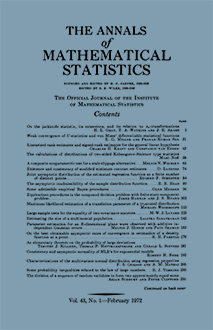Abstract
The two inversion formulas considered here arise from study of G. A. Campbell's work on the Poisson summation, which is described more fully in the introduction and in the main consists of finding a function or mapping of a variable connected with the summation in terms of a normal (Gaussian) variable $g$. More generally, this last is a process often called "normalization of the variable" and associated with the names of E. A. Cornish and R. A. Fisher. The mapping is two-way and the main inversion formula determines co-efficients for one way from those for the other, both sets of coefficients being descriptive of their mappings. More precisely if $x$ is a given variable, $g$ a Gaussian variable, $y$ a parameter of the mapping, and the two mappings are $x = g + \sum^\infty_1 G_n(g) y^n/n!,$ $g = x + \sum^\infty_1 X_n(x)y^n/n!,$ the formula expresses $G_n(x)$ in terms of $X_i(x), i \leq n,$ and vice versa. The second formula is more particularly related to the Poisson summation and relates coefficients $p_n \equiv p_n(g)$ and $q_n \equiv q_n(g)$ in the pair of equations $a = c \sum^\infty_0 q_n c^{-\frac{1}{2}n}/n!$ $c = a \sum^\infty_0 p_n a^{-\frac{1}{2}n}/n!$ Both formulas, which are necessarily elaborate, are given concise expression by the use of the multi-variable polynomials of E. T. Bell.
Citation
John Riordan. "Inversion Formulas in Normal Variable Mapping." Ann. Math. Statist. 20 (3) 417 - 425, September, 1949. https://doi.org/10.1214/aoms/1177729993
Information





